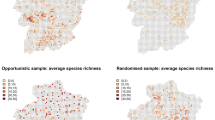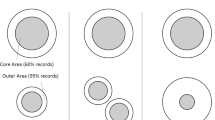Abstract
Citizen science projects can gather datasets with observation counts and spatiotemporal coverage far in excess of what can easily be achieved using only professional scientists. However, there exists a potential trade-off between the number of participants and the quality of data gathered. The Bugs Count citizen science project had thousands of participants because of its few barriers to taking part, allowing participation by anyone in England with access to any area of outdoor space. It was designed to scope for both the effects of variation in local habitat and urbanisation on broad taxonomic groups of invertebrates, and the responses of six target ‘Species Quest’ species (Adalia bipunctata, Ocypus olens, Aglais urticae, Palomena prasina, Limax maximus, and Bombus hypnorum) to urbanisation. Participants were asked to search for invertebrates in three areas: ‘soft ground surfaces’, ‘human-made hard surfaces’, and ‘plants’ for 15 min per search. Participants recorded counts of taxa found and a range of environmental information about the survey area. Data samples were weighted according to identification experience and participant age and analysed using canonical correspondence analysis, and tests of observation homogeneity. Species Quest species showed species-specific relationships with urbanisation, but broad taxonomic groups did not show significant relationships with urbanisation. The latter were instead influenced by habitat type and microhabitat availability. The approach used demonstrates that citizen science projects with few barriers to entry can gather viable datasets for scoping broad trends, providing that the projects are carefully designed and analysed to ensure data quality.


Similar content being viewed by others
References
Altermatt F (2012) Temperature-related shifts in butterfly phenology depend on the habitat. Glob Chang Biol 18:2429–2438
Angold PG, Sadler JP, Hill MO, Pullin A, Rushton S, Austin K, Small E, Wood B, Wadsworth R, Sanderson R, Thompson K (2006) Biodiversity in urban habitat patches. Sci Total Environ 360:196–204
Baker RR (1968) Sun orientation during migration in some British butterflies. Proc R Ent Soc Lond A 43:89–95
Baker RR (1972) Territorial behavior of nymphalid butterflies, Aglais urticae (L) and Inachis io (L). J Anim Ecol 41:453–469
Bates AJ, Sadler JP, Fairbrass AJ, Falk SJ, Hale JD, Matthews TJ (2011) Changing bee and hoverfly pollinator assemblages along an urban–rural gradient. Plos One 6(8):e23459. doi:10.1371/journal.pone.0023459
Bates AJ, Sadler JP, Everett G, Grundy D, Lowe N, Davis G, Baker D, Bridge M, Clifton J, Freestone R, Gardner D, Gibson C, Hemming R, Howarth S, Orridge S, Shaw M, Tams T, Young H (2013) Assessing the value of the garden moth scheme citizen science dataset: how does light trap type affect catch? Entomologia Experimentalis Et Applicata 146:386–397
Bates AJ, Sadler JP, Grundy D, Lowe N, Davis G, Baker D, Bridge M, Freestone R, Gardner D, Gibson C, Hemming R, Howarth S, Orridge S, Shaw M, Tams T, Young H (2014) Garden and landscape-scale correlates of moths of differing conservation status: significant effects of urbanisation and habitat diversity. Plos One 9(1):e86925. doi:10.1371/journal.pone.0086925
Bergerot B, Fontaine B, Renard M, Cadi A, Julliard R (2010) Preferences for exotic flowers do not promote urban life in butterflies. Landsc Urban Plan 96:98–107
Beumer C, Martens P (2015) Biodiversity in my (back)yard: towards a framework for citizen engagement in exploring biodiversity and ecosystem services in residential gardens. Sustain Sci. doi:10.1007/s11625-014-0270-8
Bone J, Archer M, Barraclough D, Eggleton P, Flight D, Head M, Jones DT, Scheib C, Voulvoulis N (2012) Public participation in soil surveys: lessons from a pilot study in England. Environ Sci Technol 46:3687–3696
Bonney R, Cooper CB, Dickinson J, Kelling S, Phillips T, Rosenberg KV, Shirk J (2009) Citizen science: a developing tool for expanding science knowledge and scientific literacy. Bioscience 59:977–984
Bonter DN, Cooper CB (2012) Data validation in citizen science: a case study from project feeder watch. Front Ecol Environ 10:305–307
Buczkowski G, Richmond DS (2012) The effect of urbanisation on ant abundance and diversity: a temporal examination of factors affecting biodiversity. Plos One 7(8):e41729. doi:10.1371/journal.pone.0041729
Cohn JP (2008) Citizen science: Can volunteers do real research? Bioscience 58:192–197
Crall AW, Newman GJ, Jarnevich CS, Stohlgren TJ, Waller DM, Graham J (2010) Improving and integrating data on invasive species collected by citizen scientists. Biol Invasions 12:3419–3428
Davies L, Bell JNB, Bone J, Head M, Hill L, Howard C, Hobbs SJ, Jones DT, Power SA, Rose N, Ryder C, Seed L, Stevens G, Toumi R, Voulvoulis N, White PCL (2011) Open air laboratories (OPAL): a community-driven research programme. Environ Pollut 159:2203–2210
Deguines N, Julliard R, de Flores M, Fontaine C (2012) The whereabouts of flower visitors: contrasting land-use preferences revealed by a country-wide survey based on citizen science. Plos One 7(9):e45822. doi:10.1371/journal.pone.0045822
Dennis RLH, Shreeve TG, Van Dyck H (2003) Towards a functional resource-based concept for habitat: a butterfly biology viewpoint. Oikos 102:417–426
Di Mauro D, Dietz T, Rockwood L (2007) Determining the effect of urbanisation on generalist butterfly species diversity in butterfly gardens. Urban Ecosyst 10:427–439
Faeth SH, Warren PS, Shochat E, Marussich WA (2005) Trophic dynamics in urban communities. Bioscience 55:399–407
Fox R, Warren MS, Brereton TM, Roy DB, Robinson A (2011) A new red list of British butterflies. Insect Conserv Divers 4:159–172
Fuller RA, Irvine KN, Devine-Wright P, Warren PH, Gaston KJ (2007) Psychological benefits of greenspace increase with biodiversity. Biol Lett 3:390–394
GeoConvert (2012) GeoConvert: an online geography matching and conversion tool for UK academics. www.geoconvert.mimas.ac.uk
Grewal SS, Grewal PS (2012) Can cities become self-reliant in food? Cities 29:1–11
Grimm NB, Faeth SH, Golubiewski NE, Redman CL, Wu JG, Bai XM, Briggs JM (2008) Global change and the ecology of cities. Science 319:756–760
Hobbs SJ, White PCL (2012) Motivations and barriers in relation to community participation in biodiversity recording. J Nat Conserv 20:364–373
Hooper DU, Chapin FS, Ewel JJ, Hector A, Inchausti P, Lavorel S, Lawton JH, Lodge DM, Loreau M, Naeem S, Schmid B, Setala H, Symstad AJ, Vandermeer J, Wardle DA (2005) Effects of biodiversity on ecosystem functioning: a consensus of current knowledge. Ecol Monogr 75:3–35
Horsák M, Lososová Z, Čejka T, Juřičková L, Chytrý M (2013) Diversity and biotic homogenization of urban land-snail faunas in relation to habitat types and macroclimate in 32 central European cities. Plos One 8(8):e71783. doi:10.1371/journal.pone.0071783
Hunter MR, Hunter MD (2008) Designing for conservation of insects in the built environment. Insect Conserv Divers 1:189–196
Imhoff ML, Bounoua L, DeFries R, Lawrence WT, Stutzer D, Tucker CJ, Ricketts T (2004) The consequences of urban land transformation on net primary productivity in the United States. Remote Sens Environ 89:434–443
Lepš J, Šmilauer P (2003) Multivariate analysis of ecological data using CANOCO. Cambridge University Press, Cambridge
Lyytimaki J, Sipila M (2009) Hopping on one leg - the challenge of ecosystem disservices for urban green management. Urban For Urban Green 8:309–315
McIntyre NE, Rango J, Fagan WF, Faeth SH (2001) Ground arthropod community structure in a heterogeneous urban environment. Landsc Urban Plan 52:257–274
McKinney ML (2008) Effects of urbanisation on species richness: a review of plants and animals. Urban Ecosyst 11:161–176
Memmott J, Waser NM, Price MV (2004) Tolerance of pollination networks to species extinctions. Proc R Soc B Biol Sci 271:2605–2611
Millennium Ecosystem Assessment (2005) Ecosystems and human well-being: biodiversity synthesis. World Resources Institute, Washington DC
Miller-Rushing A, Primack R, Bonney R (2012) The history of public participation in ecological research. Front Ecol Environ 10:285–290
Niemelä J, Kotze DJ (2009) Carabid beetle assemblages along urban to rural gradients: a review. Landsc Urban Plan 92:65–71
OPAL (2011) The Bugs Count survey. http://www.opalexplorenature.org/bugscount
OPAL (2012) Open Air Laboratories. Explore Nature. Available: http://www.opalexplorenature.org/. Accessed 2014 Jan 2. Natural History Museum
Pickett STA, Cadenasso ML, Grove JM, Boone CG, Groffman PM, Irwin E, Kaushal SS, Marshall V, McGrath BP, Nilon CH, Pouyat RV, Szlavecz K, Troy A, Warren P (2011) Urban ecological systems: scientific foundations and a decade of progress. J Environ Manag 92:331–362
Prather CM, Pelini SL, Laws A, Rivest E, Woltz M, Bloch CP, Del Toro I, Ho C-K, Kominoski J, Newbold TAS, Parsons S, Joern A (2013) Invertebrates, ecosystem services and climate change. Biol Rev Camb Philos Soc 88:327–348
Sadler JP, Small EC, Fiszpan H, Telfer MG, Niemela J (2006) Investigating environmental variation and landscape characteristics of an urban–rural gradient using woodland carabid assemblages. J Biogeogr 33:1126–1138
Sadler J, Bates A, Donovan R, Bodnar S (2011) Building for biodiversity: accomodating people and wildlife in cities. In: Niemelä J, Breuste JH, Guntenspergen G, McIntyre NE, Elmqvist T, James P (eds) Urban ecology. Patterns, processes and applications. Oxford University Press, Oxford, pp 286–297
Sattler T, Borcard D, Arlettaz R, Bontadina F, Legendre P, Obrist MK, Moretti M (2010) Spider, bee, and bird communities in cities are shaped by environmental control and high stochasticity. Ecology 91:3343–3353
Shirk JL, Ballard HL, Wilderman CC, Phillips T, Wiggins A, Jordan R, McCallie E, Minarchek M, Lewenstein BV, Krasny ME, Bonney R (2012) Public oarticipation in scientific research: a framework for deliberate design. Ecol Soc 17(2):29. doi:10.5751/ES-04705-170229
Shochat E, Warren PS, Faeth SH, McIntyre NE, Hope D (2006) From patterns to emerging processes in mechanistic urban ecology. Trends Ecol Evol 21:186–191
Shwartz A, Turbé A, Simon L, Julliard R (2014) Enhancing urban biodiversity and its influence on city-dwellers: an experiment. Biol Conserv 171:82–90
Smith RM, Gaston KJ, Warren PH, Thompson K (2006a) Urban domestic gardens (VIII): environmental correlates of invertebrate abundance. Biodivers Conserv 15:2515–2545
Smith RM, Warren PH, Thompson K, Gaston KJ (2006b) Urban domestic gardens (VI): environmental correlates of invertebrate species richness. Biodivers Conserv 15:2415–2438
Taylor JR, Taylor Lovell S (2012) Mapping public and private spaces of urban agriculture in Chicago through the analysis of high-resolution aerial images in Google Earth. Landsc Urban Plan 108:57–70
ter Braak CFJ, Šmilauer P (1998) CANOCO reference manual and user’s guide to Canoco for Windows: Software for canonical community ordination (version 4). Microcomputer Power, Ithaca
Toogood M (2013) Engaging publics: biodiversity data collection and the geographies of citizen science. Geogr Compass 7(9):611–621
Van Dyck H, Van Strien AJ, Maes D, Van Swaay CAM (2009) Declines in common, widespread butterflies in a landscape under intense human use. Conserv Biol 23:957–965
Verboven AF, Uyttenbroek R, Brys R, Hermy M (2014) Different responses of bees and hoverflies to land use in an urban–rural gradient show the importance of the nature of the rural land use. Landsc Urban Plan 126:31–41
Wilson EO (1987) The little things that run the world (the importance and conservation of invertebrates). Conserv Biol 1:344–346
Zhang Y (2013) Urban metabolism: a review of research methodologies. Environ Pollut 178:463–473
Acknowledgments
The Bugs Count survey was developed with the support of the Wildlife Gardening Forum Research Group, Richard Fox (Butterfly Conservation), Adrian Norris and Roy Anderson (Conchological Society of Great Britain and Ireland), Helen Roy (UK Ladybird Survey), Tristan Bantock, Bernard Nau and Alan Stewart (Hemiptera Recording Schemes), Stuart Hine (Natural History Museum), and Stuart Roberts (Bees, Wasps and Ants Recording Society). This research is part of the OPAL (Open Air Laboratories) project, which was funded by The National Lottery (UK) through the Big Lottery Fund. The authors thank the many citizens (both big and small) who have contributed to this research; and particularly the volunteers and community scientists that have led groups of participants. We also thank the two anonymous reviewers and Urban Ecosystems review staff that have helped considerably improve earlier drafts of this paper.
Author information
Authors and Affiliations
Corresponding author
Rights and permissions
About this article
Cite this article
Bates, A.J., Lakeman Fraser, P., Robinson, L. et al. The OPAL bugs count survey: exploring the effects of urbanisation and habitat characteristics using citizen science. Urban Ecosyst 18, 1477–1497 (2015). https://doi.org/10.1007/s11252-015-0470-8
Published:
Issue Date:
DOI: https://doi.org/10.1007/s11252-015-0470-8




